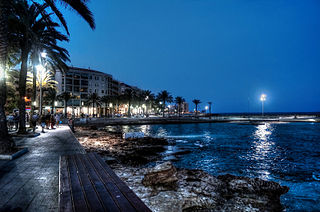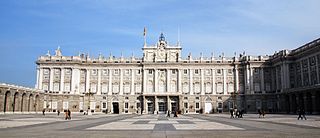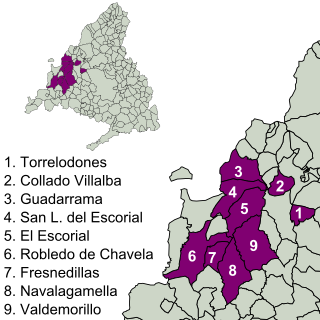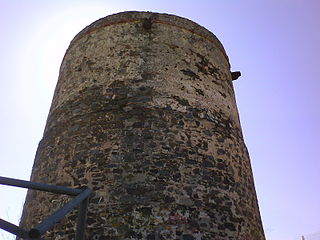
The Alhambra is a palace and fortress complex located in Granada, Andalusia, Spain. It is one of the most famous monuments of Islamic architecture and one of the best-preserved palaces of the historic Islamic world, in addition to containing notable examples of Spanish Renaissance architecture.

Torrevieja is a seaside city and municipality located on the Costa Blanca in the province of Alicante, in the southern part of the Valencian Community, on the southeastern Mediterranean coast of Spain.

A watchtower or watch tower is a type of fortification used in many parts of the world. It differs from a regular tower in that its primary use is military and from a turret in that it is usually a freestanding structure. Its main purpose is to provide a high, safe place from which a sentinel or guard may observe the surrounding area. In some cases, non-military towers, such as religious towers, may also be used as watchtowers.

Juan de Herrera was a Spanish architect, mathematician and geometrician.

Spanish architecture refers to architecture in any area of what is now Spain, and by Spanish architects worldwide. The term includes buildings which were constructed within the current borders of Spain prior to its existence as a nation, when the land was called Iberia, Hispania, or was divided between several Christian and Muslim kingdoms. Spanish architecture demonstrates great historical and geographical diversity, depending on the historical period. It developed along similar lines as other architectural styles around the Mediterranean and from Central and Northern Europe, although some Spanish constructions are unique.

Mejorada is a village located in the province of Toledo, Castile-La Mancha, Spain. According to the 2017 census (INE), the municipality has a population of 2,809 inhabitants.

The Herrerian style of architecture was developed in Spain during the last third of the 16th century under the reign of Philip II (1556–1598), and continued in force in the 17th century, but transformed by the Baroque style of the time. It corresponds to the third and final stage of Spanish Renaissance architecture, whose dominant trend had been towards austerity and minimal decoration. The ornate Plateresque style had given way to classical Purism in the second third of the 16th century. Purism in turn had given way to the geometric simplicity of the Herrerian style.

Torrelodones is a municipality in the northwest of the Autonomous Community of Madrid, Spain. It is situated 29 kilometers northwest from the city of Madrid. Because of its location between the Sierra de Guadarrama and the metropolitan area of the capital, it is linked to two districts in Madrid: the agricultural area of Guadarrama and the metropolitan area of Madrid.
The Alcázar of Jerez de la Frontera is a former Moorish alcázar, now housing a park, in Jerez de la Frontera, in the South of Spain. It was declared a Bien de Interés Cultural in 1931.

The Church of San Dionisio is a church located in Jerez de la Frontera, Andalusia, Spain. It was built in the late 15th century in Gothic-Mudéjar style, although its interior was later renovated in Baroque style by architects Diego Antonio Díaz and Pedro de Silva. It was declared Bien de Interés Cultural in 1964.

The Torre de los Adalides was a rectangular medieval look-out tower of Islamic design located in the vicinity of Algeciras, Spain. It was situated roughly 1 kilometre (0.62 mi) from the coast on a hill some 100 metres (330 ft) above sea level in the area which is now covered by the city's northern suburbs. The tower was demolished by the Spaniards during the Spanish–American War as they thought the Americans might use it as a base of their own. The ruins of the tower are within military limits and cannot be approached without a formal permit.
The 2015 Copa de la Reina de Fútbol was the 33rd edition of the Spanish women's football national cup. It ran from 10 to 17 May 2015 and it was contested by the best eight teams in the 2014–15 Spanish Championship. Both the quarterfinals were single-elimination in Las Rozas and Torrelodones, while the semifinals and final was held in Melilla.

The Muslim Walls of Madrid, of which some vestiges remain, are located in the Spanish city of Madrid. They are probably the oldest construction extant in the city. They were built in the 9th century, during the Muslim domination of the Iberian Peninsula, on a promontory next to Manzanares river. They were part of a fortress around which developed the urban nucleus of Madrid. They were declared an Artistic-Historic Monument in 1954.
The Christian Walls of Madrid, also known as the Medieval Walls, were built in Madrid, Spain between the 11th and 12th centuries, once the city passed to the Crown of Castile. They were built as an extension of the original 9th-century Muslim Walls of Madrid to accommodate the new districts which emerged after the Reconquista.

The Tower of Bones is an Islamic watchtower, the remains of which are exhibited in the underground parking structure in the Plaza de Oriente, in the Spanish city of Madrid. It was built in the 11th century by the Muslim population that founded the Mayrit fortress two centuries earlier, as an integral part of its defensive system.

The Cuenca Alta del Manzanares Regional Park, created in 1985, is the natural space protected area with the largest extension in the Community of Madrid (Spain) and one of the most ecologically and scenically valuable. It is located in the northwest of the region and extends around the upper course of the Manzanares River, along 42 583 ha. Its main municipalities of reference are Manzanares el Real and Hoyo de Manzanares. Unesco declared it a Biosphere Reserve in 1992.

The Sierra de Hoyo or Sierra de Hoyo de Manzanares is a mountain chain located in the northwest of the Community of Madrid (Spain), near the Sierra de Guadarrama. Geologically it belongs to this mountainous formation, but there is a flat separation of about ten kilometers between the two. Its main municipality of reference is Hoyo de Manzanares, located on its southern slope, from which it takes its name.

The Imperial Route of the Community of Madrid is the tourist itinerary promoted by the Ministry of Culture and Tourism of this Spanish region, which runs through several municipalities in the Sierra de Guadarrama. It partially follows the historical road that led to the Monastery of El Escorial, used in the 16th century by King Philip II in his travels from the city of Madrid to the Royal Site.

The Torre del Catalán is a watchtower located in Lepe, in the province of Huelva (Spain), declared Bien de Interés Cultural.

















